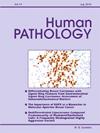高级别 B 细胞淋巴瘤:双击和非双击
IF 2.7
2区 医学
Q2 PATHOLOGY
引用次数: 0
摘要
过去几十年来,高级别 B 细胞淋巴瘤(HGBL)的分类不断演变。根据目前的定义,这类肿瘤约占所有非霍奇金淋巴瘤的 2%,而且这类肿瘤患者在接受标准治疗后往往会出现难治或复发。世界卫生组织血液肿瘤分类(WHO-HAEM5)第五版完善了 HGBL 的分类,并确认了两种类型:(1) 弥漫大 B 细胞淋巴瘤(DLBCL)/HGBL,伴 MYC 和 BCL2 重排,伴或不伴 BCL6 重排;(2) HGBL,未另作规定(HGBL-NOS)。WHO-HAEM5 将同时伴有 MYC 和 BCL6 重排的 DLBCL/HGBL 排除在这一类别之外,并根据形态学将其分别重新归入 DLBCL 或 HGBL-NOS 类别。国际共识分类(ICC)采用的方法略有不同。除了承认两个 WHO-HAEM5 类别外,他们还承认同时存在 MYC 和 BCL6 重排的 HGBL 为临时实体。在本综述中,我们对 HGBL 及其亚组进行了更新,重点介绍了其临床病理特征、诊断、分子遗传特征和发病机制。我们还讨论了诊断方法和鉴别诊断的注意事项,重点是与 B 淋巴细胞白血病/淋巴瘤的鉴别诊断。本文章由计算机程序翻译,如有差异,请以英文原文为准。
High-grade B-cell lymphomas: Double hit and non-double hit
The classification of high-grade B-cell lymphoma (HGBL) has continuously evolved over past decades. These neoplasms, as currently defined, represent about 2% of all non-Hodgkin lymphomas and patients with these neoplasms are often refractory or relapsed following standard therapy. The 5th edition of the World Health Organization classification of hematologic neoplasms (WHO-HAEM5) has refined the classification of HGBL and recognizes two types: (1) Diffuse large B-cell lymphoma (DLBCL)/HGBL with MYC and BCL2 rearrangements, with or without BCL6 rearrangements; and (2) HGBL, not otherwise specified (HGBL-NOS). WHO-HAEM5 excluded DLBCL/HGBL with concurrent MYC and BCL6 rearrangements from this category and reclassified them into DLBCL or HGBL-NOS categories respectively based on morphology. The International Consensus Classification (ICC) takes a slightly different approach. In addition to recognizing the two WHO-HAEM5 categories, they recognize HGBL with concurrent MYC and BCL6 rearrangements as a provisional entity. In this review, we provide an update of HGBL and its subgroups, focusing on their clinicopathologic features, diagnosis, molecular genetic features, and pathogenesis. Our diagnostic approach and caveats for differential diagnosis are also discussed with an emphasis on the differential diagnosis with B lymphoblastic leukemia/lymphoma.
求助全文
通过发布文献求助,成功后即可免费获取论文全文。
去求助
来源期刊

Human pathology
医学-病理学
CiteScore
5.30
自引率
6.10%
发文量
206
审稿时长
21 days
期刊介绍:
Human Pathology is designed to bring information of clinicopathologic significance to human disease to the laboratory and clinical physician. It presents information drawn from morphologic and clinical laboratory studies with direct relevance to the understanding of human diseases. Papers published concern morphologic and clinicopathologic observations, reviews of diseases, analyses of problems in pathology, significant collections of case material and advances in concepts or techniques of value in the analysis and diagnosis of disease. Theoretical and experimental pathology and molecular biology pertinent to human disease are included. This critical journal is well illustrated with exceptional reproductions of photomicrographs and microscopic anatomy.
 求助内容:
求助内容: 应助结果提醒方式:
应助结果提醒方式:


